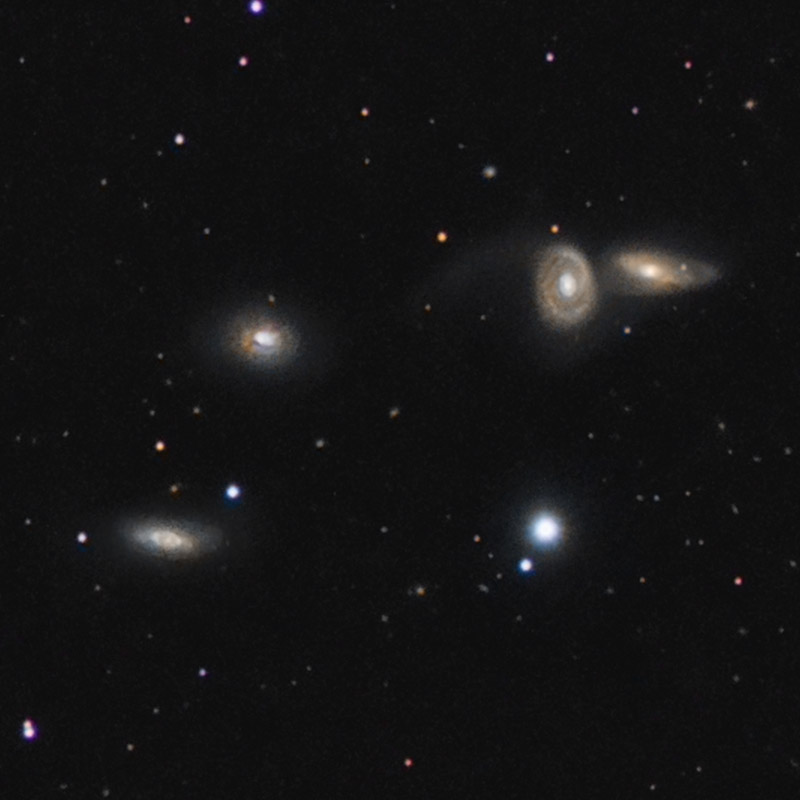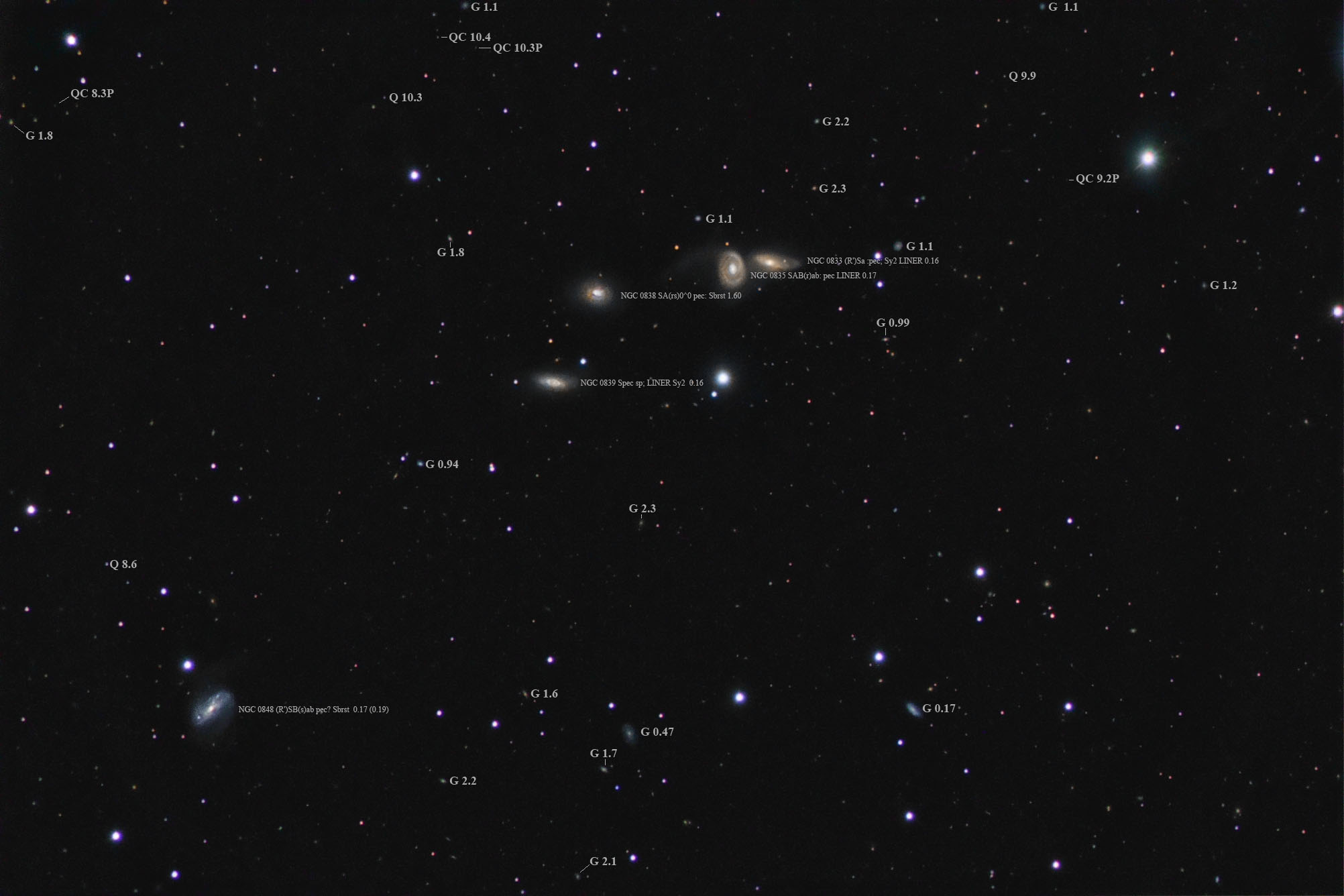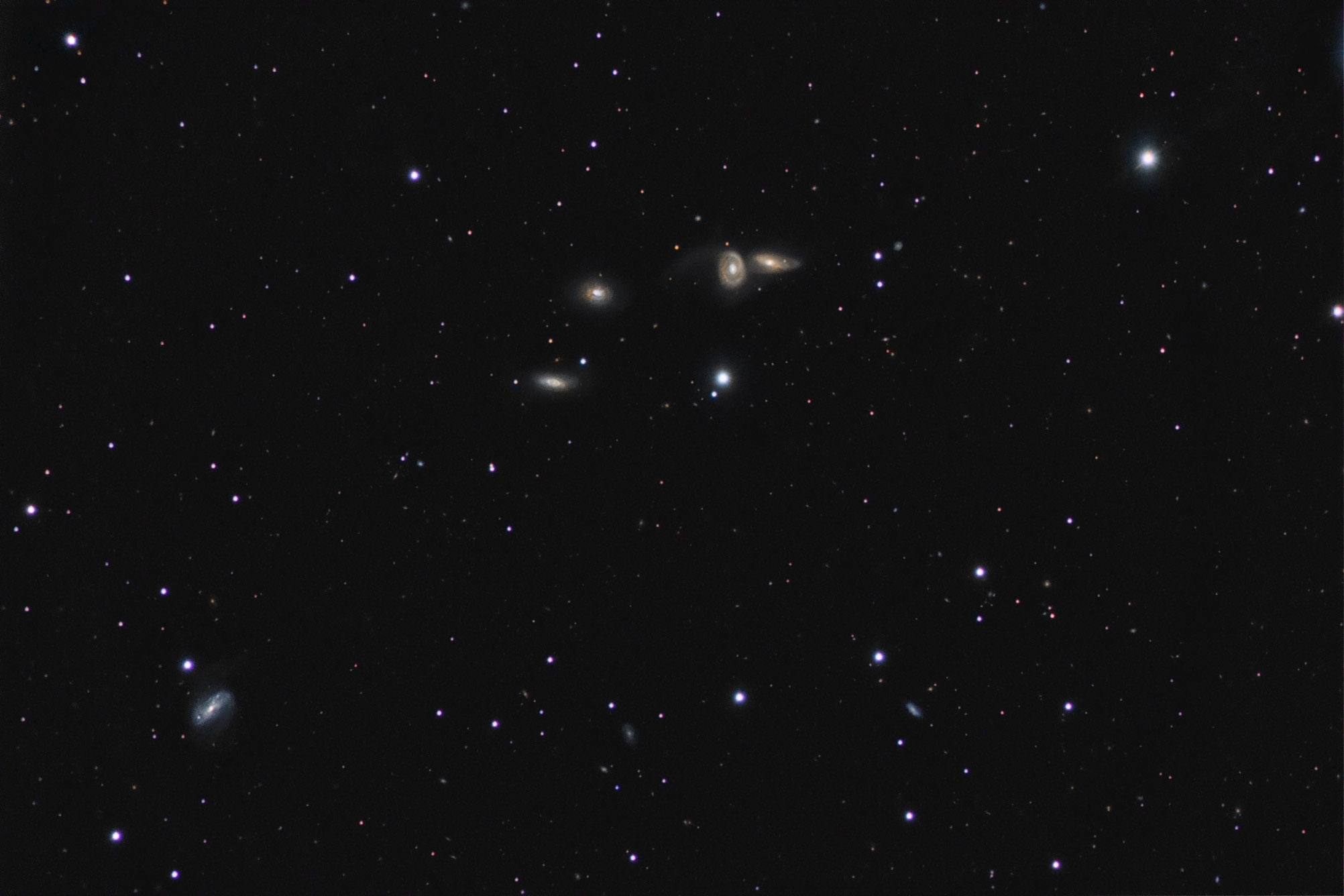| Description | Images |
Object name: ARP318Designation(s): ARP318, NGC0833, NGC0835, NGC0838, NGC0839, NGC0848, HCG18, Arp 318 is a group of 4 galaxies also known as Hickson 16. It is in the constellation of Cetus and is about 160 million light years distant. Hickson 16 consists of 4 galaxies but Arp 318 may consist of 5. Depends on your source. Arp's image only includes 4 of the 5. The 5th is too far for the 200" to image it with the others. With other large objects, Arp went with the 48" Schmidt photo, however. Since he didn't here I'll assume 4 is correct but the 5th is in my image so won't escape my covering it. Related Designation(s):1RXS J020939.1-100906, 1WGA J0209.6-1008, 1WGA J0209.7-1011, 1WGA J0210.2-1019, 2MASS J02092085-1007591, 2MASS J02092459-1008092, 2MASX J02092086-1007591, 2MASX J02092458-1008091, 2MASX J02093853-1008466, 2MASX J02094273-1011016, 2MASX J02101756-1019157, 2MASXi J0209246-100809, 2MASXi J0209386-100846, 2MASXi J0209427-101102, 2MASXi J0210175-101915, 6dF J0209208-100759, 6dF J0209209-100759, 6dF J0209246-100809, 6dF J0210176-101916, AGC 420027, AKARI J0209248-100808, AKARI J0209384-100840, AKARI J0209427-101059, AKARI J0210175-101912, ARP 258, ARP 318, ARP 318 NED01, ARP 318 NED02, ARP 318 NED03, ARP 318 NED04, ARP 318:[MNP2009] C1, ARP 318:[MNP2009] C2, ARP 318:[MNP2009] C3, ARP 318:[MNP2009] RN, ARP318, ASK 132414.0, ASK 132418.0, ASK 132419.0, CGCG 0236.3+1810, CGCG 462-037, CXO J020920.8-100759, CXO J020924.5-100808, CXO J020938.5-100848, CXO J020942.8-101102, CXO J021017.6-101922, EXSS 0207.1-1022, GALEXASC J020938.50-100846.7 , GALEXASC J020942.89-101057.9 , GSC 5281 00942, GSC 5281 01260, GSC 5281 01672, GSC 5281 01919, GSC 5281 02119, HCG 016, HCG 016:[dRC97] 01, HCG 016:[dRC97] 01a, HCG 016:[dRC97] 02, HCG 016:[dRC97] 02b, HCG 016:[dRC97] 03, HCG 016:[dRC97] 04, HCG 016:[dRC97] 04c, HCG 016:[dRC97] 05, HCG 016:[dRC97] 05d, HCG 016A, HCG 016B, HCG 016C, HCG 016D, HCG 016X, HCG 018, HCG18, HDCE 0121 NED001, HDCE 0121 NED002, HDCE 0121 NED003, HDCE 0121 NED004, HDCE 0121 NED005, HIPASS J0209-10:[MHF2006] S1 , HIPASS J0209-10:[MHF2006] S2 , HIPASS J0209-10:[MHF2006] S3 , HIPASS J0209-10:[MHF2006] S4 , HIPASS J0209-10:[SMD2013] S01 , HIPASS J0209-10:[SMD2013] S02 , HIPASS J0209-10:[SMD2013] S03 , HIPASS J0209-10:[SMD2013] S04 , IRAS 02069-1022, IRAS 02072-1025, IRAS 02078-1033, IRAS F02069-1022, IRAS F02071-1023, IRAS F02072-1025, IRAS F02078-1033, ISOSS J02103-1019, KUG 0206-103, KUG 0207-103, KUG 0207-105, LDCE 0146 NED001, LDCE 0146 NED002, LDCE 0146 NED003, LDCE 0146 NED004, LDCE 0146 NED005, LGG 049:[G93] 002, LGG 049:[G93] 003, LGG 049:[G93] 004, LGG 049:[G93] 005, LGG 049:[G93] 006, LQAC 032-010 002, LQAC 032-010 003, MBG 02070-1022, MBG 02072-1022, MBG 02078-1033, MCG -02-06-030, MCG -02-06-031, MCG -02-06-033, MCG -02-06-034, MCG -02-06-036, MRK 1021, MRK 1022, MRK 1026, NGC 0833, NGC 0835, NGC 0835:[KCP2006] 1, NGC 0835:[KCP2006] 2, NGC 0835:[KCP2006] 3, NGC 0838, NGC 0838 E, NGC 0838 S, NGC 0838 W, NGC 0838 W2, NGC 0838E, NGC 0838S, NGC 0838W, NGC 0839, NGC 0848, NGC0833, NGC0835, NGC0838, NGC0839, NGC0848, NSA 023272, NSA 023274, NSA 131308, NVSS J020924-100808, NVSS J020938-100846, NVSS J020942-101101, NVSS J021017-101912, PGC 008225, PGC 008228, PGC 008250, PGC 008254, PGC 008299, RSCG 19, RX J0209.4-1008, SDSS J020920.84-100759.0, SDSS J020920.84-100759.1, SDSS J020924.60-100809.3, SDSS J020938.52-100846.5, SDSS J020938.55-100847.5, SDSS J020938.57-100846.3, SDSS J020938.58-100846.2, SDSS J020938.59-100846.1, SSTSL2 J020920.84-100759.0, SSTSL2 J020924.60-100809.4, SSTSL2 J020938.49-100847.0, USGC S077 NED01, USGC S077 NED02, USGC S077 NED03, USGC S077 NED04, USGC S077 NED05, v2MCG 12:[DMP2012] 1, v2MCG 12:[DMP2012] 2, v2MCG 12:[DMP2012] 3, v2MCG 12:[DMP2012] 4, v2MCG 12:[DMP2012] 5, VV 143, [BKD2008] WR 136, [dML87] 042, [GMM2009b] 06, [GMM2009b] 07, [LRM2015] J020939-100844, [PCM2000] 21 NED01, [PCM2000] 21 NED02, [PJY2015] 587727177926508588 , [RdC96] 01, [RdC96] 02, [RdC96] 03, [RdC96] 04, [RdC96] 05, [RHM2006] LIRGs 019, [RHM2006] SFGs 044, [RHM2006] SFGs 124, [RHM2006] SFGs 154, [SLK2004] 0279, [VCV2001] J020920.9-100759, [VCV2001] J020924.6-100811, [VCV2006] J020920.9-100759, [VCV2006] J020924.6-100811, | Permanent link: https://images.mantrapskies.com/catalog/ARP-GALAXIES/ARP318-NGC0833-NGC0835-NGC0838-NGC0839-NGC0848-HCG18/ARP318L3X10EGB2X10X3R-CROP150.JPG |


